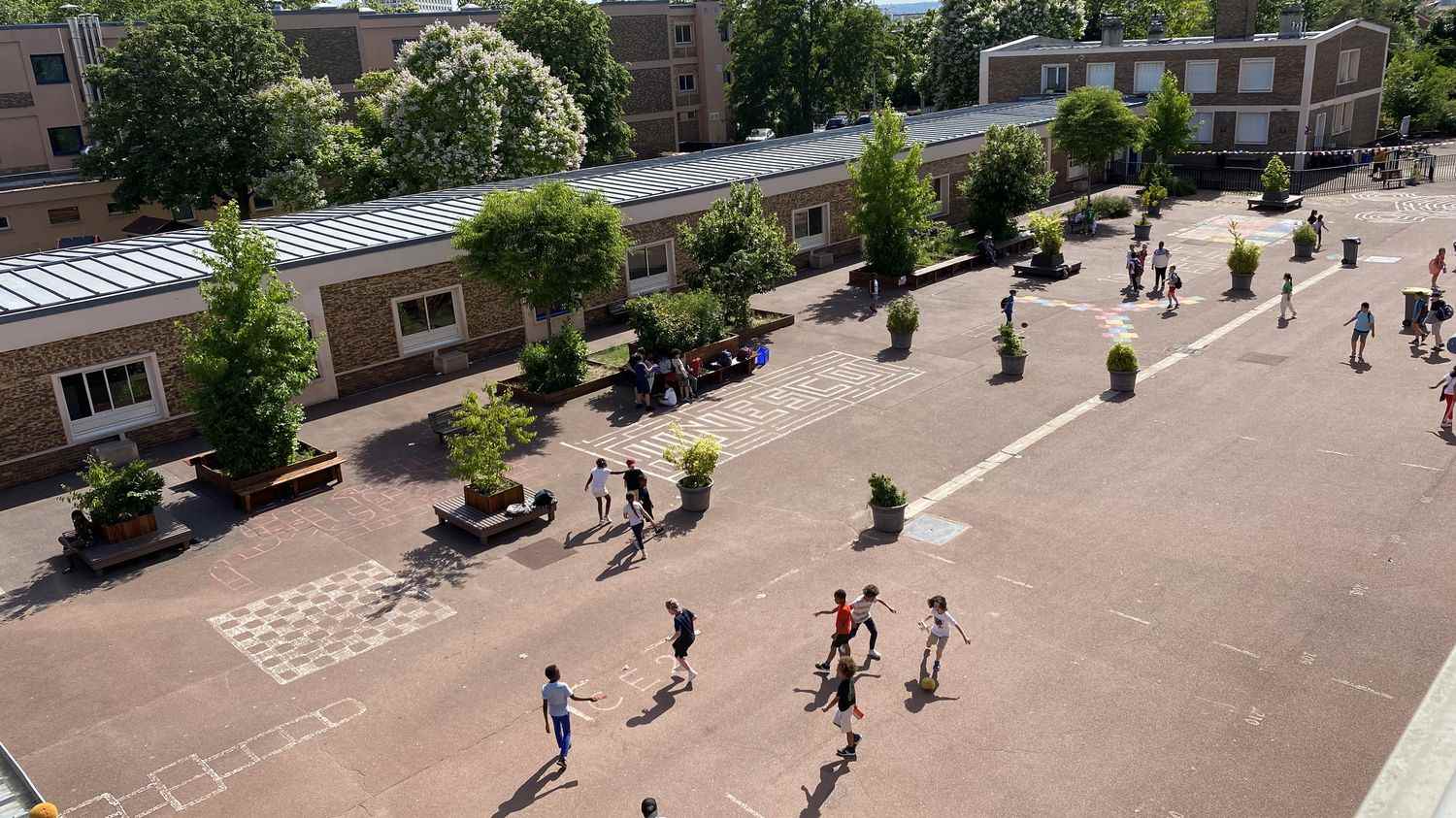Yasmine Azzouz looks at the thermometer she had installed in her classroom. “28°C, when I have just ventilated and the students are not there, it’s too much”, slice the teacher of CM1-CM2. On this Thursday, June 16, the Honoré de Balzac primary school, a priority education establishment with 320 students in Nanterre (Hauts-de-Seine), was hit by an exceptionally early and intense heat wave, like a large part of the country. “When it’s so hot, they are not concentrated at all. I changed the program to do manual work, but even that is complicated”she testifies.
The teacher, however, spares no pains to relieve her students: she has installed her small personal fan and bought misters to bring down the temperature. In his class, the blinds work, but the upper part of the windows are not covered. Children’s drawings on cardboard therefore act as shutters. It’s even worse in the courtyard, where the franceinfo thermometer displays, in a few minutes of exposure, a stunning 39.3 ° C. “There is very little shade and it is in full sunnotes Yasmine Azzouz. When they come back up, they’re dead”.

French schools are faced with heat waves like our society is faced with global warming: they were not designed to withstand them and they are not ready. By injecting large doses of greenhouse gases into the atmosphere to move, build, feed or manufacture objects, man did not invent heat waves, but he made them more intense and earlier. They are no longer reserved for the summer months, during which schools are closed. “In recent years, we have had heat waves during class time, in May, June, September…”notes Eric Pateyron, director of the Honoré de Balzac school since 1998.
Faced with this situation, we must adapt. Before our eyes, the director lectures a group of children running after a ball: “Go get some shade.” “I have a cap”tries one of the students, without success. “With the heat it is doing, it’s not enough”, replies the director. On the ground floor, another class reads in the coolness of a room facing due north and protected by the trees of the neighboring street. “Before, we didn’t put too many students there, we found it too cold and dark. Now, it’s an advantage”, comments the director. Planters and trees have been installed in the courtyard in recent years to provide some shade.
To prepare for the coming climate, we will have to go a little further than these adjustments. Since the start of the industrial era, the planet has warmed by 1.1°C. The commitments made by the States within the framework of the Paris agreement lead us for the moment towards a world at +2.7°C. Like other cities, Nanterre has decided to green the courses of its schools, with an envelope of 750,000 euros by 2026. In their latest report (PDF link in English)IPCC scientists insist on the multiple benefits of water and trees in cities: CO2 storage, cooling of the temperature, improvement of air quality, and the mental and physical health of the inhabitants. .

At the Honoré de Balzac school, work is planned for this summer. The courtyard will be cut over 30% of its surface, to install trees and grass. A logical continuation for this establishment which already has a small botanical garden, used for educational activities. “Vegetation is not an option for us, it is essential”insists Eric Pateyron, drawing with his hand the contours of the future wooded area.
Just push the door next door to grasp the interest of the approach. The Les Bizis leisure center, which adjoins the school, has had a 3,600 m² garden since 2020. There is an orchard, groves, an unmown meadow, a vegetable patch and all kinds of plants, thanks to the generosity of a botanic store which graciously donates its unsold products. “There could have been a block of buildings instead”, recalls Robert Ridel, the neighborhood coordinator. A neighbor of Paris, the city of Nanterre is indeed whetting appetites for real estate.
In the grass, it is 30°C, nine colder than in the yard. “The trees hide us from the heat”summarizes quickly Haroun, 9 years old, between two answers to the specific questions of the facilitator on the plants which surround them. “It’s a great chance to have this space”, welcomes Morgane De Bernardi, deputy director of the center. In office for a few months, she left a school without trees for this garden. “It’s much nicer to work here”she admits.

Beyond freshness, the garden has other virtues for children, according to Hyacinthe Jauniau, the host. “I see it when they arrive, they are calmershe observes. They watch the plants, the insects, and they learn a lot better.” The deputy mayor in charge of educational action, Jean-Pierre Bellier, has a formula to sum things up: “Tackling the weather climate has an impact on the school climate”. In her classroom, Yasmine Azzouz impatiently awaits the end of the work: “With all this area of open ground, it will be great”. The teacher shows us on the wall a model of the ideal courtyard imagined by her students. A rectangle of grass covers much of the space.
